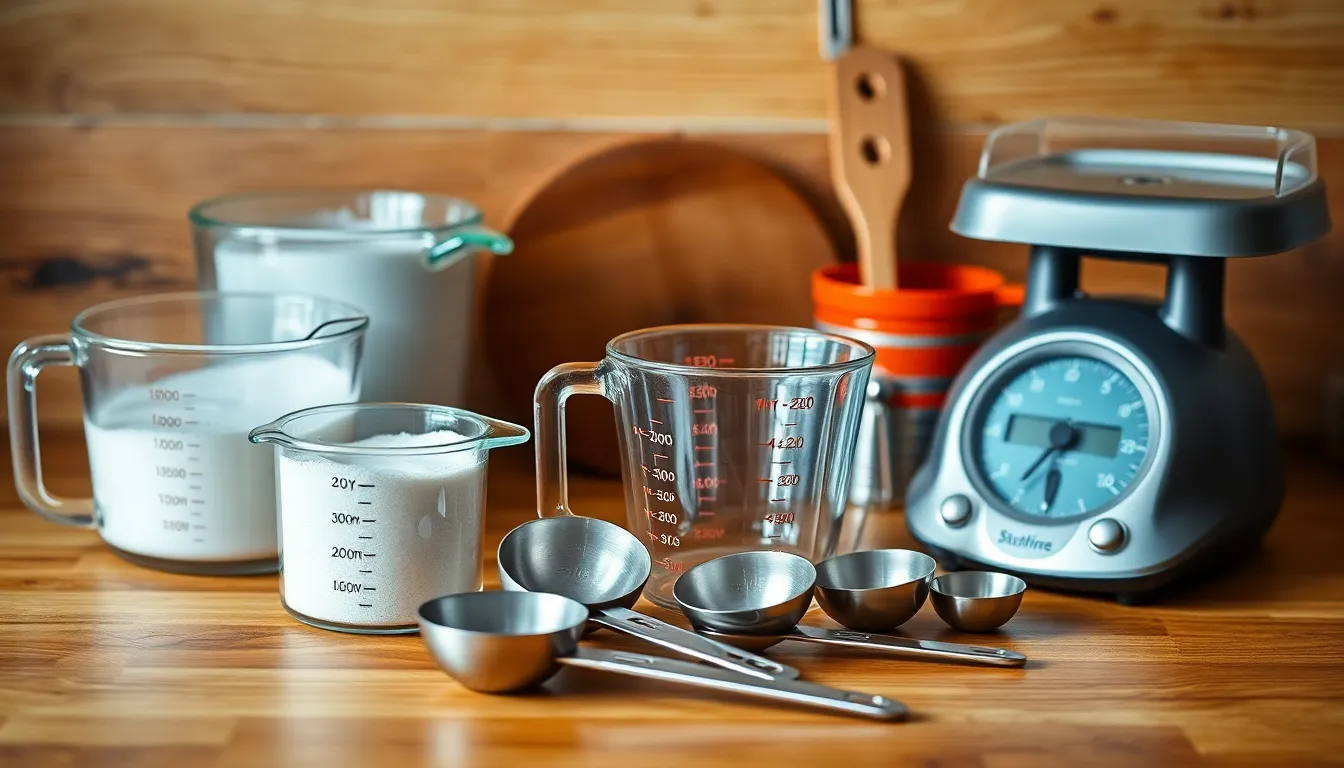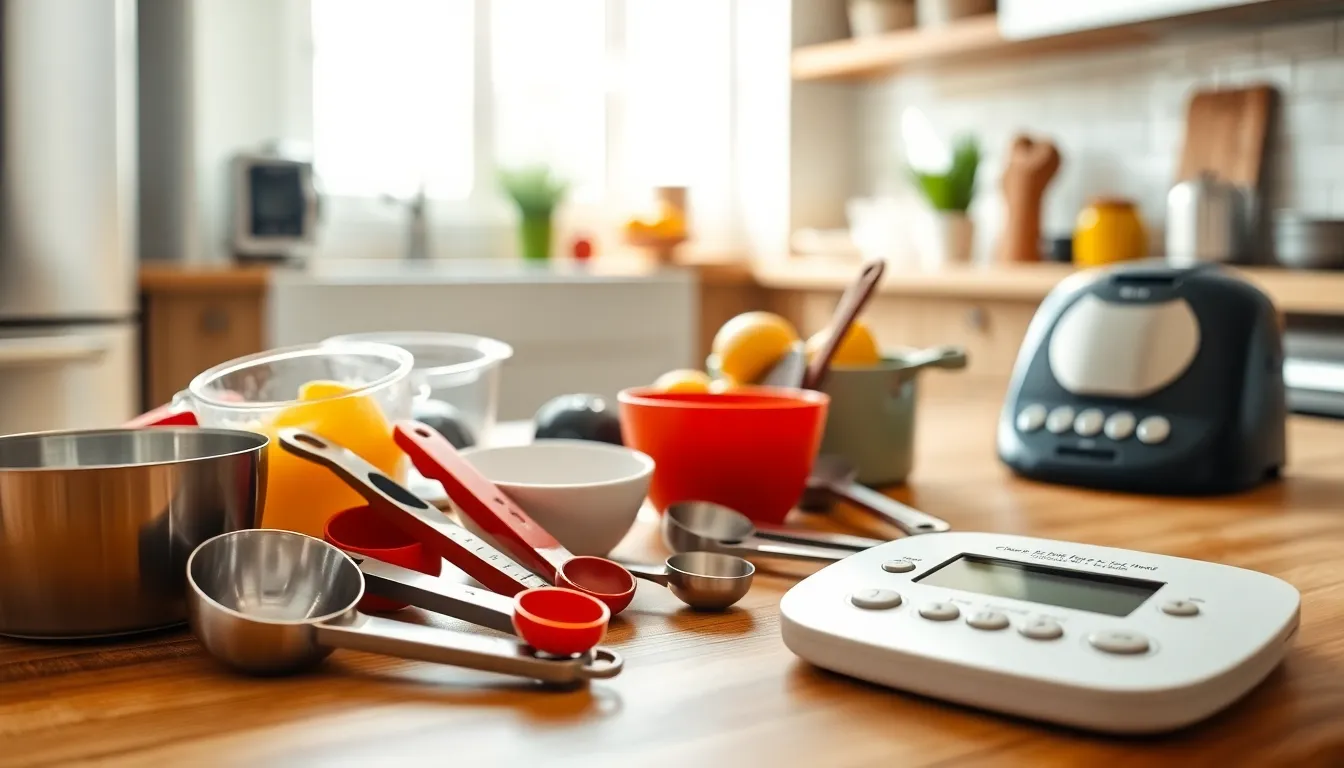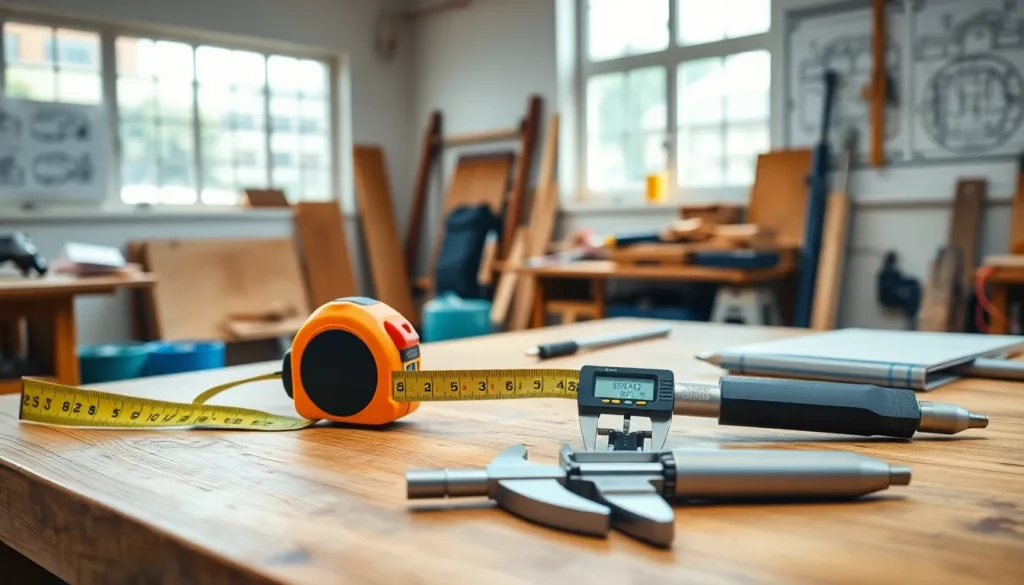In the bustling world of cooking, precision is key. Imagine whipping up a soufflé only to discover you’ve added a tablespoon of salt instead of sugar. Yikes! Kitchen measuring tools aren’t just gadgets; they’re the unsung heroes of culinary success. From spoons that promise to deliver the perfect pinch to cups that measure out just the right amount of flour, these tools can make or break a dish.
Table of Contents
ToggleOverview of Kitchen Measuring Tools
Kitchen measuring tools play a crucial role in achieving precise cooking results. Measuring cups, for instance, offer varying sizes to accommodate different ingredient volumes. These cups usually come in both dry and liquid variants, ensuring versatility in recipes.
Measuring spoons present another key tool for accuracy. They typically include measurements like teaspoons, tablespoons, and sometimes even fractional sizes. This assortment allows for customizable seasoning levels, which enhances flavor profiles.
Digital scales offer a modern solution for measuring weight accurately. Bakeries, in particular, favor these scales, as they ensure consistent ingredient ratios, vital for perfect baked goods. Many digital scales also provide units conversion, simplifying the process for users.
Kitchen thermometers ensure that foods reach the desired temperatures. Instant-read thermometers provide quick results for meats and baked items, while candy thermometers are designed specifically for confectionery tasks. These tools safeguard against undercooked or overly cooked dishes.
Additionally, liquid measuring tools feature spouts and measurement markings for precision. Glass or plastic varieties often include a clear gauge, making for easy reading while pouring.
Various specialty tools enhance efficiency in the kitchen. For example, metric measuring jugs facilitate international recipes, and a scale can also assist in converting recipes into a different measuring system easily.
Accurate measurement streamlines culinary processes and eliminates guesswork. Emphasizing the right tools ensures a more enjoyable cooking experience and consistently high-quality results.
Types of Kitchen Measuring Tools

Kitchen measuring tools come in various types, each serving a specific purpose in the culinary process. Selecting the correct tool enhances accuracy and improves cooking results.
Dry Measuring Cups
Dry measuring cups excel in measuring solid ingredients. Commonly, they come in sets of different sizes, typically ranging from 1/4 cup to 1 cup. Each cup delivers precise measurements for flour, sugar, or grains. For best results, filling the cup to the brim and leveling off with a straight edge ensures accuracy. These cups often feature a handle for comfortable pouring and are generally made from plastic or stainless steel for durability.
Liquid Measuring Cups
Liquid measuring cups provide accuracy for measuring liquids. Typically made of glass or clear plastic, their transparent design allows for easy reading of measurements. The spout aids in pouring without spills, enhancing convenience. It’s common to find measurements marked in both standard and metric units, accommodating diverse recipe requirements. Standard sizes usually include 1 cup, 2 cups, and larger capacities. By using these cups, cooks can ensure liquids like water, broth, or oils are measured correctly.
Measuring Spoons
Measuring spoons assist in accurately measuring small amounts of ingredients. They come in sets that often include 1 tablespoon, 1 teaspoon, and fractional sizes like 1/2 and 1/4 teaspoons. Various materials, including stainless steel or plastic, typically comprise these tools. Each spoon is designed for ease of use and storage, often featuring a ring or clip to keep them organized. Accurate seasoning is achieved by carefully filling each spoon without packing the ingredients, ensuring flavor balance in dishes.
Kitchen Scales
Kitchen scales play an essential role in achieving precise weight measurements. Digital scales, favored for their accuracy, provide quick readings and often allow for conversion between units like grams and ounces. Many scales feature tare functions, enabling users to subtract bowl weight, ensuring only the ingredient measurement counts. Styles often range from compact, portable versions to larger models with extensive capacities. Using a kitchen scale promotes consistency, especially in baking, where precise ratios significantly impact the final product.
Importance of Accurate Measurements
Accurate measurements play a crucial role in achieving culinary success. Precision ensures that recipes produce consistent results.
Impact on Cooking and Baking
Measurement accuracy significantly influences cooking and baking outcomes. Inconsistent measurements can affect texture, flavor, and appearance. For instance, too much flour in a cake recipe may yield a dry, dense product. Using precise tools like measuring cups and digital scales provides confidence during the process. Chefs rely on these tools to maintain ingredient ratios, resulting in balanced dishes. Enhanced accuracy contributes to replicable recipes, allowing home cooks to recreate restaurant-quality meals effortlessly. Time and effort spent measuring accurately pay off in the end, making each culinary endeavor an enjoyable experience.
Common Measurement Mistakes
Common measurement mistakes often lead to disappointing dishes. Using the wrong measuring tool can cause miscalculations. For example, utilizing a liquid measuring cup for dry ingredients may lead to excessive amounts. Additionally, not leveling off dry ingredients when measuring is a frequent error that impacts baking outcomes. Some cooks forget to account for ingredient density variations, leading to weight discrepancies. Forgetting to check for measurement conversions can also create problems, particularly in international recipes. Avoiding these pitfalls requires diligence and attention to detail. By being mindful of common errors, cooks can improve accuracy and elevate their cooking skills.
Choosing the Right Measuring Tools
Selecting the proper measuring tools plays a critical role in achieving accurate results in the kitchen. Understanding the various aspects of these tools helps elevate cooking skills significantly.
Material Considerations
Material affects durability and effectiveness. Stainless steel measuring cups provide longevity and resistance to bending. Glass options offer stability and allow for easy reading of measurements. Plastic measuring tools tend to be lightweight and often come with clear markings. Each material serves specific purposes, so choosing according to cooking needs enhances performance and reliability in the kitchen. For example, heavier materials withstand rigorous use better than lighter ones.
Size and Capacity
Size and capacity are vital attributes when selecting measuring tools. Sets typically include various sizes, facilitating the measurement of both small and large quantities. Commonly, dry measuring cups range from 1/4 cup to 1 cup, while liquid measuring cups often hold a quart. Understanding specific capacity needs ensures accurate ingredient measurement for diverse recipes. For instance, utilizing the right size prevents overflow and helps avoid discrepancies in seasoning and ingredient ratios. Aim to choose tools that fit comfortably in storage while meeting measurement requirements efficiently.
Maintenance and Care Tips
Keeping kitchen measuring tools in top shape ensures long-lasting performance. Regular cleaning after each use prevents residue buildup, especially on those measuring spoons and cups. Use warm, soapy water for standard materials like stainless steel and glass, while plastic tools require gentler care to avoid scratching.
Storing measuring tools properly can prevent damage. Hanging measuring cups on hooks saves space and reduces risk of scratches. For those measuring spoons, consider using drawer organizers to prevent them from tangling or losing.
Calibration checks add precision to measurements over time. Regularly checking the accuracy of digital scales helps maintain their reliability. Weighing known samples periodically affirms consistency in readings.
Avoiding extreme temperatures preserves the integrity of tools. Glass measuring containers may break if subjected to sudden temperature changes. Keeping tools away from direct heat sources ensures longevity, especially for plastic materials.
Monitor for wear and tear, especially in digital scales and thermometers. Replacing batteries regularly keeps electronic tools functional. Signs of fading markings on measuring cups indicate the need for replacement to maintain accuracy.
Using appropriate utensils when measuring can prevent scratches and warping. Silicone spatulas and soft brushes ensure precise measuring without damaging surfaces. Avoid abrasive pads that may scratch or degrade tools.
Following these maintenance tips enhances the lifespan and accuracy of kitchen measuring tools, ensuring optimal performance for all culinary endeavors. Prioritizing care contributes to achieving precise ingredient measurements, essential for successful cooking outcomes.
Mastering the art of cooking hinges on precision and the right tools. Kitchen measuring tools are indispensable for anyone looking to elevate their culinary skills. By investing in quality measuring cups, spoons, scales, and thermometers, cooks can ensure accuracy in every dish.
Proper maintenance and care of these tools further enhance their effectiveness and longevity. With the right instruments at hand, cooks can confidently tackle recipes, avoid common measurement pitfalls, and achieve consistent results. Embracing these tools not only simplifies the cooking process but also transforms the kitchen into a space of creativity and culinary success.










